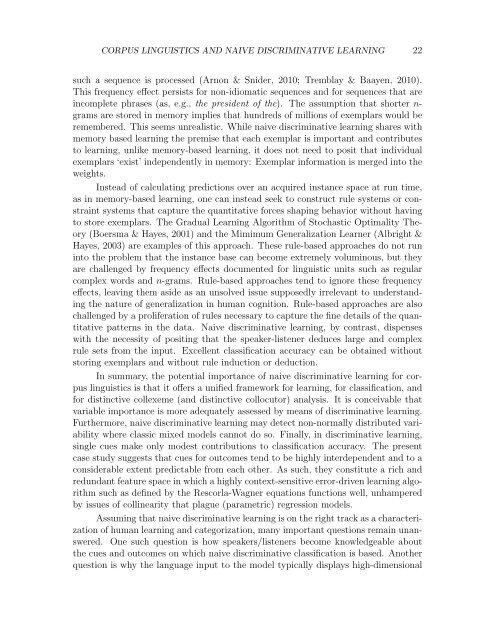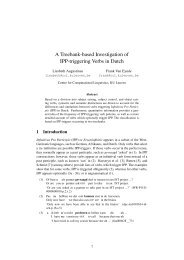Corpus linguistics and naive discriminative learning - University of ...
Corpus linguistics and naive discriminative learning - University of ...
Corpus linguistics and naive discriminative learning - University of ...
Create successful ePaper yourself
Turn your PDF publications into a flip-book with our unique Google optimized e-Paper software.
CORPUS LINGUISTICS AND NAIVE DISCRIMINATIVE LEARNING 22<br />
such a sequence is processed (Arnon & Snider, 2010; Tremblay & Baayen, 2010).<br />
This frequency effect persists for non-idiomatic sequences <strong>and</strong> for sequences that are<br />
incomplete phrases (as, e.g., the president <strong>of</strong> the). The assumption that shorter n-<br />
grams are stored in memory implies that hundreds <strong>of</strong> millions <strong>of</strong> exemplars would be<br />
remembered. This seems unrealistic. While <strong>naive</strong> <strong>discriminative</strong> <strong>learning</strong> shares with<br />
memory based <strong>learning</strong> the premise that each exemplar is important <strong>and</strong> contributes<br />
to <strong>learning</strong>, unlike memory-based <strong>learning</strong>, it does not need to posit that individual<br />
exemplars ‘exist’ independently in memory: Exemplar information is merged into the<br />
weights.<br />
Instead <strong>of</strong> calculating predictions over an acquired instance space at run time,<br />
as in memory-based <strong>learning</strong>, one can instead seek to construct rule systems or constraint<br />
systems that capture the quantitative forces shaping behavior without having<br />
to store exemplars. The Gradual Learning Algorithm <strong>of</strong> Stochastic Optimality Theory<br />
(Boersma & Hayes, 2001) <strong>and</strong> the Mimimum Generalization Learner (Albright &<br />
Hayes, 2003) are examples <strong>of</strong> this approach. These rule-based approaches do not run<br />
into the problem that the instance base can become extremely voluminous, but they<br />
are challenged by frequency effects documented for linguistic units such as regular<br />
complex words <strong>and</strong> n-grams. Rule-based approaches tend to ignore these frequency<br />
effects, leaving them aside as an unsolved issue supposedly irrelevant to underst<strong>and</strong>ing<br />
the nature <strong>of</strong> generalization in human cognition. Rule-based approaches are also<br />
challenged by a proliferation <strong>of</strong> rules necessary to capture the fine details <strong>of</strong> the quantitative<br />
patterns in the data. Naive <strong>discriminative</strong> <strong>learning</strong>, by contrast, dispenses<br />
with the necessity <strong>of</strong> positing that the speaker-listener deduces large <strong>and</strong> complex<br />
rule sets from the input. Excellent classification accuracy can be obtained without<br />
storing exemplars <strong>and</strong> without rule induction or deduction.<br />
In summary, the potential importance <strong>of</strong> <strong>naive</strong> <strong>discriminative</strong> <strong>learning</strong> for corpus<br />
<strong>linguistics</strong> is that it <strong>of</strong>fers a unified framework for <strong>learning</strong>, for classification, <strong>and</strong><br />
for distinctive collexeme (<strong>and</strong> distinctive collocutor) analysis. It is conceivable that<br />
variable importance is more adequately assessed by means <strong>of</strong> <strong>discriminative</strong> <strong>learning</strong>.<br />
Furthermore, <strong>naive</strong> <strong>discriminative</strong> <strong>learning</strong> may detect non-normally distributed variability<br />
where classic mixed models cannot do so. Finally, in <strong>discriminative</strong> <strong>learning</strong>,<br />
single cues make only modest contributions to classification accuracy. The present<br />
case study suggests that cues for outcomes tend to be highly interdependent <strong>and</strong> to a<br />
considerable extent predictable from each other. As such, they constitute a rich <strong>and</strong><br />
redundant feature space in which a highly context-sensitive error-driven <strong>learning</strong> algorithm<br />
such as defined by the Rescorla-Wagner equations functions well, unhampered<br />
by issues <strong>of</strong> collinearity that plague (parametric) regression models.<br />
Assuming that <strong>naive</strong> <strong>discriminative</strong> <strong>learning</strong> is on the right track as a characterization<br />
<strong>of</strong> human <strong>learning</strong> <strong>and</strong> categorization, many important questions remain unanswered.<br />
One such question is how speakers/listeners become knowledgeable about<br />
the cues <strong>and</strong> outcomes on which <strong>naive</strong> <strong>discriminative</strong> classification is based. Another<br />
question is why the language input to the model typically displays high-dimensional
















